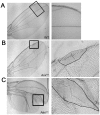Wing defects in Drosophila xenicid mutant clones are caused by C-terminal deletion of additional sex combs (Asx)
- PMID: 19956620
- PMCID: PMC2779589
- DOI: 10.1371/journal.pone.0008106
Wing defects in Drosophila xenicid mutant clones are caused by C-terminal deletion of additional sex combs (Asx)
Abstract
Background: The coordinated action of genes that control patterning, cell fate determination, cell size, and cell adhesion is required for proper wing formation in Drosophila. Defects in any of these basic processes can lead to wing aberrations, including blisters. The xenicid mutation was originally identified in a screen designed to uncover regulators of adhesion between wing surfaces [1].
Principal findings: Here, we demonstrate that expression of the betaPS integrin or the patterning protein Engrailed are not affected in developing wing imaginal discs in xenicid mutants. Instead, expression of the homeotic protein Ultrabithorax (Ubx) is strongly increased in xenicid mutant cells.
Conclusion: Our results suggest that upregulation of Ubx transforms cells from a wing blade fate to a haltere fate, and that the presence of haltere cells within the wing blade is the primary defect leading to the adult wing phenotypes observed.
Conflict of interest statement
Figures





References
-
- Fristrom D, Fristrom JW. The metamorphic development of the adult epidermis; In: Martinez-Arias A, Bates M, editors. Cold Spring Harbor, NY: Cold Spring Harbor Laboratory Press; 1993.
-
- Brower DL. Platelets with wings: the maturation of Drosophila integrin biology. Curr Opin Cell Biol. 2003;15:607–613. - PubMed
-
- Brown NH, Gregory SL, Martin-Bermudo MD. Integrins as mediators of morphogenesis in Drosophila. Dev Biol. 2000;223:1–16. - PubMed
-
- Dominguez-Gimenez P, Brown NH, Martin-Bermudo MD. Integrin-ECM interactions regulate the changes in cell shape driving the morphogenesis of the Drosophila wing epithelium. J Cell Sci. 2007;120:1061–1071. - PubMed
Publication types
MeSH terms
Substances
Grants and funding
LinkOut - more resources
Full Text Sources
Molecular Biology Databases

